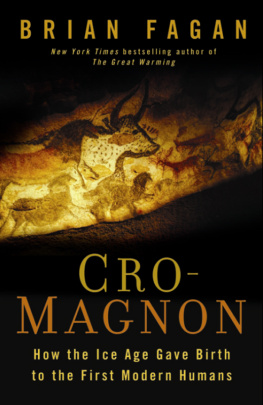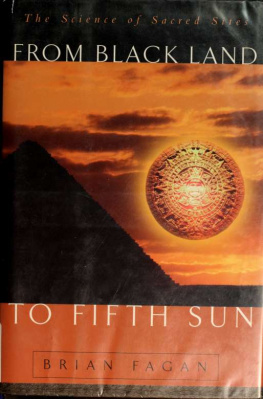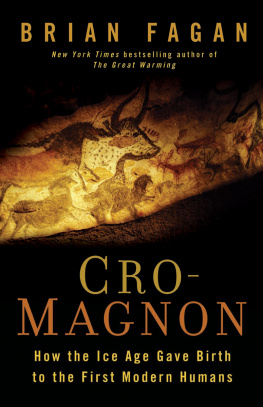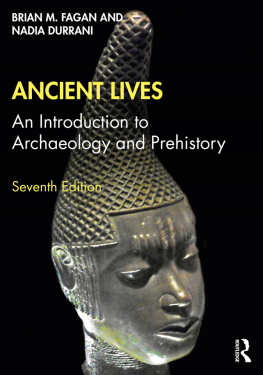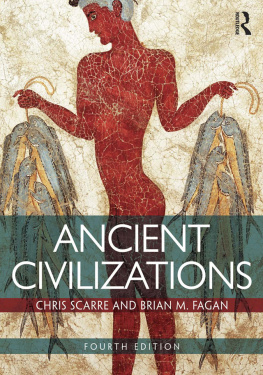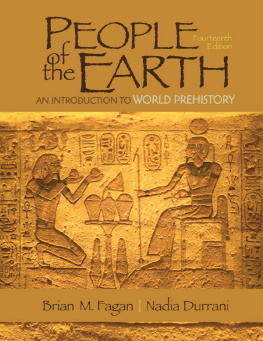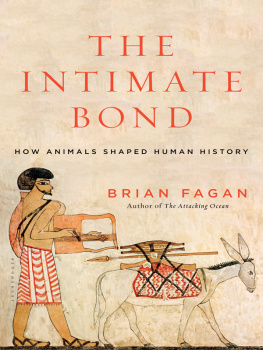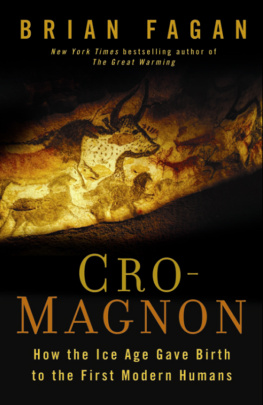Copyright 2010 by Brian Fagan
All rights reserved. No part of this book may be used or reproduced in any manner whatsoever without written permission from the publisher except in the case of brief quotations embodied in critical articles or reviews. For information address
Bloomsbury Press, 175 Fifth Avenue, New York, NY 10010.
Published by Bloomsbury Press, New York
LIBRARY OF CONGRESS CATALOGING-IN-PUBLICATION DATA
Fagan, Brian M.
Cro-Magnon : how the Ice Age gave birth to the first modern
humans / Brian Fagan. 1st U.S. ed.
p. cm.
Includes bibliographical references and index.
ISBN- 13: 978- 1- 59691- 582- 4 (hardcover)
ISBN- 10: 1- 59691- 582- X (hardcover)
1. Cro-Magnons. 2. Human evolution. 3. Glacial epoch. 4. Neanderthals. 5. Prehistoric peoples. I. Title.
GN286.3.F34 2010
569.9'8dc22
200902524.
First published by Bloomsbury Press in 2010
This e-book edition published in 2010
E-book ISBN: 978-1-60819-167-3
www.bloomsburypress.com
Contents
FOUR DOTS MOVE ALONG A RIVERBANK in a black and gray Ice Age landscape of forty thousand years ago, the only signs of life on a cold, late-autumn day. Dense morning mist swirls gently over the slow-moving water, stirring fitfully in an icy breeze. Pine trees crowd the riverbank, close to a large clearing where aurochs and bison paw through the snow for fodder. The fur-clad Cro-Magnon family moves slowly a hunter with a handful of spears, his wife carrying a leather bag of dried meat, a son and a daughter. The five-year-old boy dashes to and fro brandishing a small spear. His older sister stays by her mother, also carrying a skin bag. A sudden gust lifts the clinging gloom on the far side of the stream. Suddenly, the boy shouts and points, then runs in terror to his mother. The children burst into tears and cling to her. A weathered, hirsute face with heavy brows stares out quietly from the undergrowth on the other bank. Expressionless, yet watchful, its Neanderthal owner stands motionless, seemingly oblivious to the cold. The father looks across, waves his spear, and shrugs. The face vanishes as silently as it appeared.
As light snow falls, the family resumes its journey, the father always watchful, eyes never still. During the climb to the rock shelter, he tells his children about their elusive, quiet neighbors, rarely seen and almost never encountered face-to-face. There were more of them in his fathers and grandfathers day, when he saw them for the first time. Now sightings are unusual, especially in the cold months. They are people different from us, he explains. They do not speak like we do; we cannot understand them, but they never do us any harm. We just ignore them...
Cro-Magnons and Neanderthals: this most classic of historical confrontations, sometimes couched in terms of brutish savagery versus human sophistication, has fascinated archaeologists for generations. On the one side stand primordial humans, endowed with great strength and courage, possessed of the simplest of clothing and weaponry. We speculate that they were incapable of fully articulate speech and had relatively limited intellectual powers. On the other are the Cro-Magnons, the first anatomically modern Europeans, with fully modern brains and linguistic abilities, a penchant for innovation, and all the impressive cognitive skills of Homo sapiens. They harvested game large and small effortlessly with highly efficient weapons and enjoyed a complex, refined relationship with their environment, their prey, and the forces of the supernatural world. We know that the confrontation ended with the extinction of the Neanderthals, perhaps about thirty thousand years ago. But how it unfolded remains one of the most challenging and intriguing of all Ice Age mysteries.
The Neanderthals appeared on the academic stage with the discovery of the browridged skull of what seemed to be a primitive human in Germanys Neander Valley in 1856. Seven years later, Thomas Henry Huxleys brilliant study of the cranium in his Mans Place in Nature compared the Neanderthal fossil with the skulls of humankinds primate relatives, chimpanzees and gorillas. The thought of a human ancestry among the apes horrified many Victorians. Public opinion carved out a vast chasm between archaic humanity, epitomized by the Neander Valley skull, and the modern humans discovered in the Cro-Magnon rock shelter at Les Eyzies, in southwestern France, in 1868. The Neanderthals became primitive cave people armed with clubs, dragging their mates around by their long hair. Unfortunately, the stereotype persists to this day.
Cutting-edge science paints a very different portrait of the Neanderthals. They were strong, agile people who thrived in a harsh, often extremely cold Europe, from the shores of the Atlantic deep into Eurasia, from the edges of the steppe to warmer, drier environments in the Near East. Neanderthal hunters stalked large, dangerous animals like bison, then killed them with heavy thrusting spears. They didnt have the luxury of standing off at a distance and launching light spears at their prey. But, for all their strength and skill, they were no matches for the Cro-Magnon newcomers, who, science tells us, spread rapidly across Europe around forty-five thousand years ago. Their hunting territories were small; they were thin on the ground; the routine of their lives changed infinitesimally from one year to the next.
When they arrived in their new homeland, the Cro-Magnons were us, members of a species with a completely unprece dented relationship with the world around them. Every Cro-Magnon family, every band, was drenched in symbolism, expressed in numerous ways. Well before thirty thousand years ago, Cro-Magnons were creating engravings and paintings on the walls of caves and rock shelters. They crafted subtle and beautiful carvings on bone and antler and kept records by incising intricate notations on bone plaques. We know that they used bone flutes at least thirty-five thousand years ago, and if they did this, they surely sang and danced in deep caves by firelight on winter evenings and at summer gatherings. Cro-Magnons ornamented their bodies and buried their dead with elaborate grave goods for use in an afterlife. No one doubts that Cro-Magnon symbolic expression somehow reflects their notion of their place in the natural world. But their perceived relationship to nature was poles apart from our ownthey were hunter-gatherers and lived in a world that was unimaginably different from todays Europe. And their perceptions of the world, of existence, were radically different from, and infinitely more sophisticated than, those of the Neanderthals.

